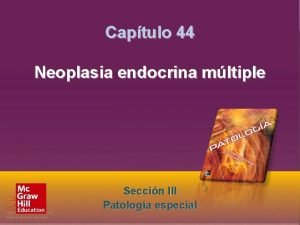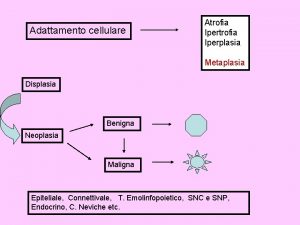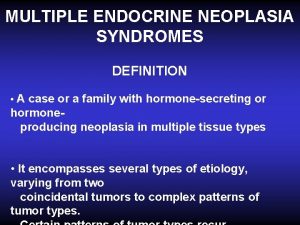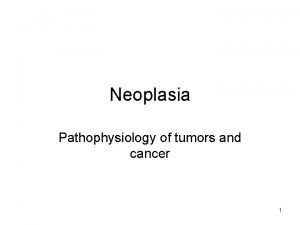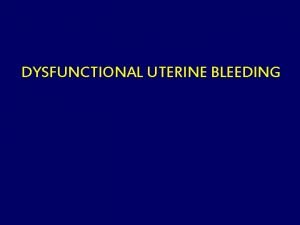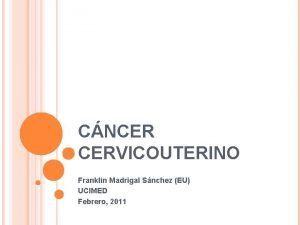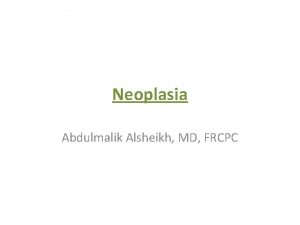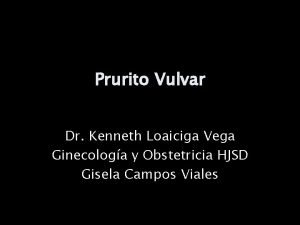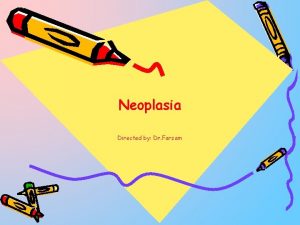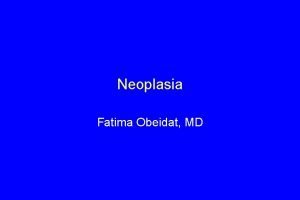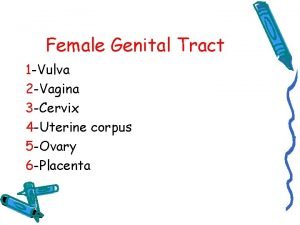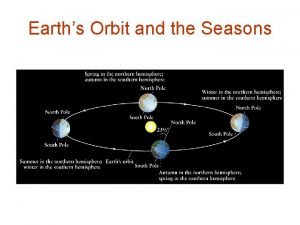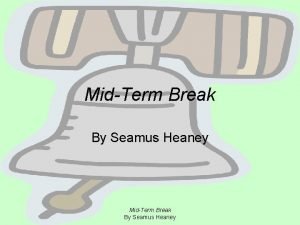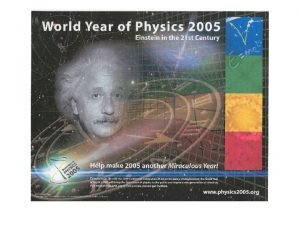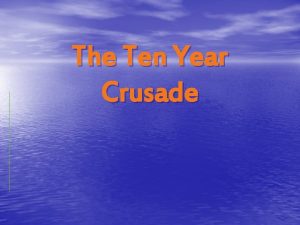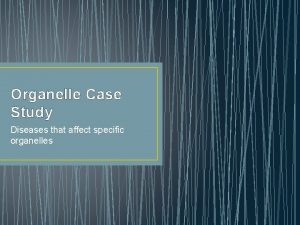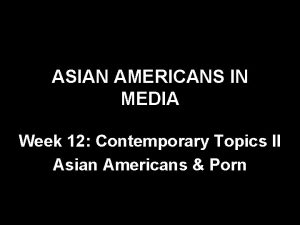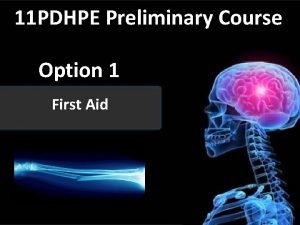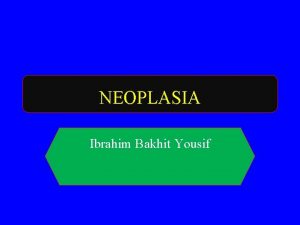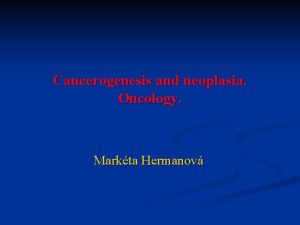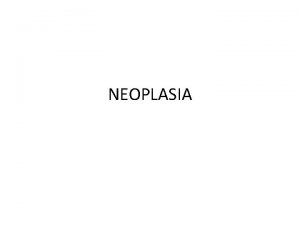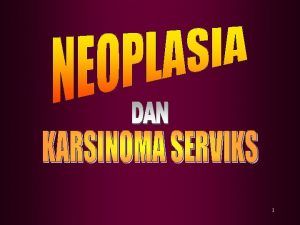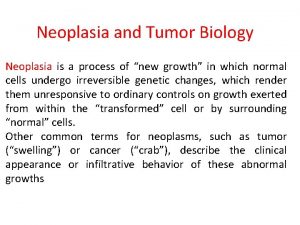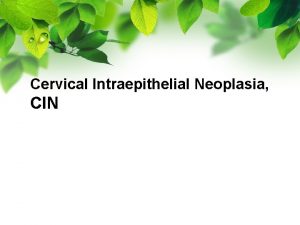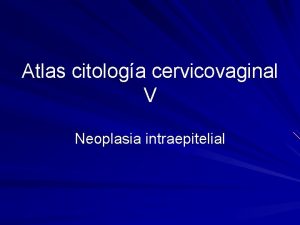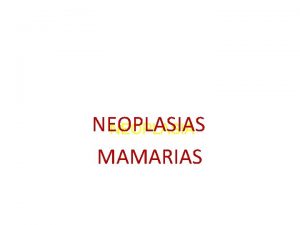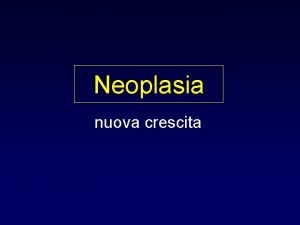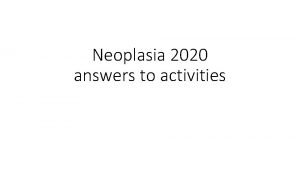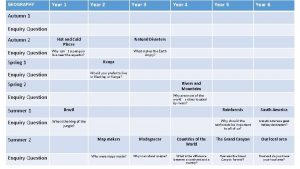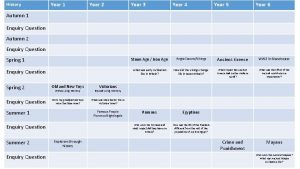Neoplasia 4 3 rd year 30520 Neoplasia 4








































- Slides: 40

Neoplasia . 4

3 rd year: 30/5/20 Neoplasia. 4 Prof Dr. Tariq Mughal

Geographic & Environmental n Sun exposure n. Melanomas 6 x incidence New Zealand vs. Iceland n. Blacks have low incidence of melanoma, so do normally pigmented areas like areolae on white people n Smoking and alcohol abuse

Geographic & Environmental n Body mass-FAT is biggest factor in sex specific , high incidence cancers , i. e. , prostate and breast Overweight = 50% increase in cancer Environmental vs. racial factors : Japanese immigrants to n n USA n Viral exposure Human papilloma virus (HPV) and cervical cancer n Hepatitis B virus (HBV) and liver cancer (Africa, Asia) n Epstein-Barr Virus (EBV) and lymphoma n

Change In Incidence Of Various Cancers With Migration From Japan To The United States

Figure 7 -25 The change in incidence of various cancers with migration from Japan to the United States provides evidence that the occurrence of cancers is related to components of the environment that differ in the two countries. The incidence of each kind of cancer is expressed as the ratio of the death rate in the population being considered to that in a hypothetical population of California whites with the same age distribution; the death rates for whites are thus defined as 1. The death rates among immigrants and immigrants' sons tend consistently toward California norms.

Epidemiology : Predisposing Factors for Cancer n Age n Most cancers occur in persons ≥ 55 years n Childhood cancers n Leukemias & CNS neoplasms n Bone tumors n Genetic predisposition n Familial cancer syndromes n Early age at onset n Two or more primary relatives with the cancer (“soil” theory) n Multiple or bilateral tumors n Polymorphisms that metabolize procarcinogens , e. g. , nitrites

Epidemiology: Predisposing Factors for Cancer n Nonhereditary predisposing conditions n. Chronic inflammation? n. Precancerous conditions n. Chronic ulcerative colitis n. Atrophic gastritis of pernicious anemia n. Leukoplakia of mucous membranes n. Immune collapse?

MOLECULAR BASIS of CANCER n n n NON-lethal genetic damage A tumor is formed by the clonal expansion of a single precursor cell (monoclonal) Four classes of normal regulatory genes n n n PROTO-oncogenes Oncoproteins DNA repair genes Apoptosis genes Carcinogenesis is a multistep process A proto-ncogene is a normal gene that can become an oncogene due to mutations or increased expressi on. Protooncogenes code for proteins that help to egulate cell growth and differe ntiation.

TRANSFORMATION & PROGRESSION n n n n The various aspects of “malignant Self-sufficiency in growth signals transformation”. Just like cancer itself is a Insensitivity to growth-inhibiting progression of signals increasingly Evasion of apoptosis disturbing processes, Defects in DNA repair: “Spell so is malignant checker” transformation. These are not necessarily Limitless replicative potential: exactly linear events, Telomerase but close. Angiogenesis Look at these as being Invasive ability factors in growth Metastatic ability regulation.

This is a BEAUTIFUL chart! Another way of understanding the development of malignancy in a logical way!

Cyclins are a family of proteins that control the progression of cells through the cell cycle by activating Cyclin Dependent Kinase (cdk) enzymes CDK’s (kinases) are enzymes which PHOSPHORYLATE proteins in preparation for the next phase of the cycle. G 1� S� G 2� M is regulated by Cyclins D� E� A� B, respectively, and CDKs 4� 2� 2� 1, respectively. Normal CELL CYCLE Phases INHIBITORS: Cip/Kip, INK 4/ARF Tumor (really growth) suppressor genes: p 53

ONCOGENES Signal transduction is a generic term which refers to any process by which a cell converts one kind of signal or stimulus into another. n Are MUTATIONS of NORMAL genes (PROTO-oncogenes) n Growth Factors n Growth Factor Receptors n Signal Transduction Proteins (RAS) n Nuclear Regulatory Proteins n Cell Cycle Regulators n Oncogenes code for Oncoproteins

Category PROTOOncogene Mode of Activation Associated Human Tumor GFs PDGF-β chain SIS Overexpression Fibroblast HST-1 growth factors INT-2 Overexpression TGFα Overexpression HGF Overexpression Amplification Astrocytoma Osteosarcoma Stomach cancer Bladder cancer Breast cancer Melanoma Astrocytomas Hepatocellular carcinomas Thyroid cancer Note, in every case, there is a NORMAL gene (proto-oncogene) MUTATED to become an ONCOGENE, ultimately resulting in the expression of as tumor.

Note, in every case, there is a NORMAL gene (proto-oncogene) MUTATED to become an ONCOGENE, ultimately resulting in the expression of as tumor.

Category PROTOOncogene Mode of Activation Associated Human Tumor GF Receptors EGF-receptor family ERB-B 1 (ECFR) ERB-B 2 Overexpression Amplification Squamous cell carcinomas of lung, gliomas Breast and ovarian cancers CSF-1 receptor FMS Point mutation Leukemia Receptor for neurotrophic factors PDGF receptor RET Point mutation PDGF-R Overexpression Multiple endocrine neoplasia 2 A and B, familial medullary thyroid carcinomas Gliomas Receptor for stem KIT cell (steel) factor GF: growth Factor Point mutation Gastrointestinal stromal tumors and other soft tissue tumors

Category PROTOOncogene Mode of Activation Associated Human Tumor Signal Transduction Proteins GTP-binding Nonreceptor tyrosine kinase K-RAS Point mutation Colon, lung, and pancreatic tumors H-RAS Point mutation Bladder and kidney tumors N-RAS Point mutation Melanomas, hematologic malignancies ABL Translocation Chronic myeloid leukemia Acute lymphoblastic leukemia RAS signal transduction BRAF Point mutation Melanomas WNT signal transduction β-catenin Point mutation Hepatoblastomas, hepatocellular carcinoma

PROTOOncogene Category Nuclear Regulatory Proteins Transcrip. C-MYC activators N-MYC L-MYC Mode of Activation Associated Human Tumor Translocation Burkitt lymphoma Amplification Neuroblastoma, small cell carcinoma of lung Amplification Small cell carcinoma of lung

Note, in every case, there is a NORMAL gene (proto-oncogene) MUTATED to become an ONCOGENE, ultimately resulting in the expression of as tumor.

MYC n Encodes for transcription factors n Also involved with apoptosis Myc (c. Myc) codes for a protein that binds to the DNA of other genes. When Myc is mutated, or overexpressed, the protein doesn't bind correctly, and often is a big step in the ultimate production of cancer.

P 53 and RAS p 53 n n Activates DNA repair proteins Sentinel of G 1/S transition Initiates apoptosis Mutated in more than 50% of all human cancers RAS n n n H, N, K, etc. , varieties Single most common abnormality of dominant oncogenes in human tumors Present in about 1/3 of all human cancers

Tumor (really “GROWTH”) suppressor genes It would be a good idea to n TGF-β COLON STOMACH n NF-1, 2 NEURAL TUMORS n APC/β-cadherin GI, MELANOMA n SMADs GI n E-cadherin have a familiarity with these genes, recognizing that mutations of them result in cancers. NOTE: Problems of GROWTH SUPPRESSION, result in GROWTH being UNregulated. THESE ARE ALL GROWTH SUPPRESSOR GENES WHICH, WHEN MUTATED, LOSE THEIR NORMAL ABILITY TO SUPPRESS cell crowth!!!

Tumor (really “GROWTH”) suppressor genes It would be a good idea to RB RETINOBLASTOMA n P 53 EVERYTHING!! n WT-1 WILMS TUMOR n p 16 (INK 4 a) GI, BREAST (MM if n n n inherited) BRCA-1, 2 BREAST KLF 6 PROSTATE have a familiarity with these genes, recognizing that mutations of them result in cancers. NOTE: Problems of GROWTH SUPPRESSION, result in GROWTH being UNregulated. THESE ARE ALL GROWTH SUPPRESSOR GENES WHICH, WHEN MUTATED, LOSE THEIR NORMAL ABILITY TO SUPPRESS cell crowth!!!

Evasion of APOPTOSIS n. BCL-2 np 53 n. MYC Mutations of genes resulting in EVASION of APOPTOSIS would also be a factor in carcinogenesis

DNA REPAIR GENE DEFECTS n DNA repair is like a spell checker n. HNPCC (Hereditary Non- Polyposis Colon Cancer [Lynch]): TGF-β, β-catenin, BAX n Xeroderma Pigmentosum: UV fixing gene

DNA REPAIR GENE DEFECTS n. Ataxia Telangiectasia: ATM gene n. Bloom Syndrome: defective helicase n. Fanconi anemia

LIMITLESS REPLICATIVE POTENTIAL n TELOMERES determine the limited number of duplications a cell will have, like a cat with nine lives. n TELOMERASE, present in >90% of human cancers, changes telomeres so they will have UNLIMITED replicative potential

TRANSFORMATIO N GROWTH BM INVASION ANGIOGENESIS INTRAVASATION EMBOLIZATION ADHESION EXTRAVASATION METASTATIC GROWTH etc. Another AWESOME diagram! Most important diagrammatic explanation of malignancy I have ever seen. Linear ………

Invasion Factors FOUR orderly steps of “INVASION” (aka, INFILTRATION, or INVASIVENESS) n Detachment ("loosening up") of the tumor cells from each other n Attachment to matrix components n Degradation of ECM, e. g. , collagenase, etc. n Migration of tumor cells

METASTATIC GENES? n NM 23 n KAI-1 n Ki. SS

CHROMOSOME CHANGES in CANCER n n n Often the term “gene rearrangement” has been used TRANSLOCATIONS and INVERSIONS Occur in MOST Lymphomas/Leukemias Occur in MANY (and growing numbers) of NONhematologic malignancies also

Malignancy Translocatio n Affected Genes Chronic myeloid leukemia (9; 22)(q 34; q 11 Ab 1 9 q 34 ) bcr 22 q 11 Acute leukemias (AML and ALL) (4; 11)(q 21; q 23 AF 4 4 q 21 ) MLL 11 q 23 (6; 11)(q 27; q 23 AF 6 6 q 27 ) MLL 11 q 23 Burkitt lymphoma (8; 14)(q 24; q 32 c-myc 8 q 24 ) Ig. H 14 q 32 Mantle cell lymphoma (11; 14)(q 13; q 3 Cyclin D 2) 11 q 13 Ig. H 14 q 32 Follicular lymphoma (14; 18)(q 32; q 2 Ig. H 14 q 32 1) bcl-2 18 q 21 Many/Most leukemias/lym phomas have fairly predictable chromosome translocations. Allah help you if you try to memorize this.

Carcinogenesis is “MULTISTEP” n. NO single oncogene causes cancer several oncogenes AND several tumor n. BOTH suppressor genes must be involved

Carcinogenesis is “MULTISTEP” n Gatekeeper/Caretaker concept n. Gatekeepers: ONCOGENES and TUMOR SUPPRESSOR GENES n. Caretakers: DNA REPAIR GENES n Tumor “PROGRESSION” n ANGIOGENESIS n HETEROGENEITY single cell from original

Wednesday lecture

Carcinogenesis: The USUAL (3) Suspects n Initiation/Promotion concept: n n BOTH initiators AND promotors are needed NEITHER can cause cancer by itself n INITIATORS (carcinogens) cause MUTATIONS n PROMOTORS are NOT carcinogenic by themselves, and MUST take effect AFTER initiation, NOT before n PROMOTORS enhance the proliferation of initiated cells

The concept of initiation and promotion is NOT a new concept. We always knew you needed two things to cause cancer: 1)Carcinogens, mutators 2)Factors which normally cause hyperplasia, such as steroid hormones, replicators



 Patho
Patho Patologia
Patologia Neoplasia testicular
Neoplasia testicular Displasia tanatofórica
Displasia tanatofórica Multiple endocrine neoplasia type 2
Multiple endocrine neoplasia type 2 Neoplasia
Neoplasia Willis definition of neoplasia
Willis definition of neoplasia Anovulatory bleeding
Anovulatory bleeding Neoplasia
Neoplasia Clinical features of neoplasia
Clinical features of neoplasia Que es una neoplasia
Que es una neoplasia Md frcpc definition
Md frcpc definition Kenneth loaiciga
Kenneth loaiciga Neoplasia
Neoplasia Neoplasia literally means
Neoplasia literally means Cin
Cin School leavers poem
School leavers poem Woman entrepreneur introduction
Woman entrepreneur introduction Seasons of the year earth's position
Seasons of the year earth's position What year did darcydi nucci coined it as fragmented future?
What year did darcydi nucci coined it as fragmented future? Deepening understanding year 5
Deepening understanding year 5 Mid term break poetic devices
Mid term break poetic devices School play
School play Person of the year time template
Person of the year time template 1 year forward rate formula
1 year forward rate formula What year was the treaty of versailles signed
What year was the treaty of versailles signed Cystisis
Cystisis Checklist year
Checklist year The miraculous year
The miraculous year Alicia cardell
Alicia cardell Valerie is a studious 15 year old
Valerie is a studious 15 year old Different types of rocks year 3
Different types of rocks year 3 Fiona stopped smoking last year
Fiona stopped smoking last year Ben earns $12 800 a year
Ben earns $12 800 a year Annabel ghong
Annabel ghong Classroom management mid year
Classroom management mid year Naplan writing examples
Naplan writing examples Year 9 art
Year 9 art Politics communion 000yearold holy mystery
Politics communion 000yearold holy mystery Happy new year likewise
Happy new year likewise Situational analysis pdhpe
Situational analysis pdhpe

